Marques du mobilier et sceau du Garde-Meuble de la reine Marie-Antoinette
+7
Marie-Jeanne
Bonnefoy du Plan
Mr ventier
Duc d'Ostrogothie
Gouverneur Morris
Lucius
Mr de Talaru
11 participants
LE FORUM DE MARIE-ANTOINETTE :: Le patrimoine de Marie-Antoinette :: Le mobilier et les arts décoratifs
Page 2 sur 2
Page 2 sur 2 •  1, 2
1, 2
 Re: Marques du mobilier et sceau du Garde-Meuble de la reine Marie-Antoinette
Re: Marques du mobilier et sceau du Garde-Meuble de la reine Marie-Antoinette
Il ne s'agit pas du numéro 40 mais du 49 selon examen plus attentif des marques , le bas du 9 étant en partie masqué.
Quant au fait que le nom de Bonnefoy du Plan soit mentionné, cela n'indique pas forcément qu'il s'agisse que ces chaises lui aient été affectées . Son nom apparait parfois sur d'autres mobilier qui ont été commandés par lui pour le garde-meuble privé de la reine .
Ces chaises ont donc pu être livrées pour la suite de la reine à l'attique aussi , mais l'hypothèse du concierge lui-même est tout aussi plausible.
N’oublions pas non plus que le mobilier des maisonnettes du du Hameau bénéficiait aussi de cette numérotation spéciale
Quant au fait que le nom de Bonnefoy du Plan soit mentionné, cela n'indique pas forcément qu'il s'agisse que ces chaises lui aient été affectées . Son nom apparait parfois sur d'autres mobilier qui ont été commandés par lui pour le garde-meuble privé de la reine .
Ces chaises ont donc pu être livrées pour la suite de la reine à l'attique aussi , mais l'hypothèse du concierge lui-même est tout aussi plausible.
N’oublions pas non plus que le mobilier des maisonnettes du du Hameau bénéficiait aussi de cette numérotation spéciale


hastur- Messages : 541
Date d'inscription : 22/12/2013
 Re: Marques du mobilier et sceau du Garde-Meuble de la reine Marie-Antoinette
Re: Marques du mobilier et sceau du Garde-Meuble de la reine Marie-Antoinette
Merci beaucoup, messieurs, pour le partage de vos connaissances... 


La nuit, la neige- Messages : 18132
Date d'inscription : 21/12/2013
 Re: Marques du mobilier et sceau du Garde-Meuble de la reine Marie-Antoinette
Re: Marques du mobilier et sceau du Garde-Meuble de la reine Marie-Antoinette
La présentation au catalogue est quasi copiée-collée d'une précédente déjà publiée page 1 de ce sujet, mais enfin bon...les photos sont soignées. 
Sera prochainement présenté en vente aux enchères :
Plateau à écrire royal en acajou moucheté d'époque Louis XVI
vers 1780
Le plateau cintré sur le devant, ceint d’une fine moulure, marque au feu " MA" couronné et "GARDE MEUBLE DE LA REINE" au revers
Haut. 16 cm, larg. 59 cm, prof. 38,5 cm
Provenance : Garde-Meuble privé de la reine Marie-Antoinette
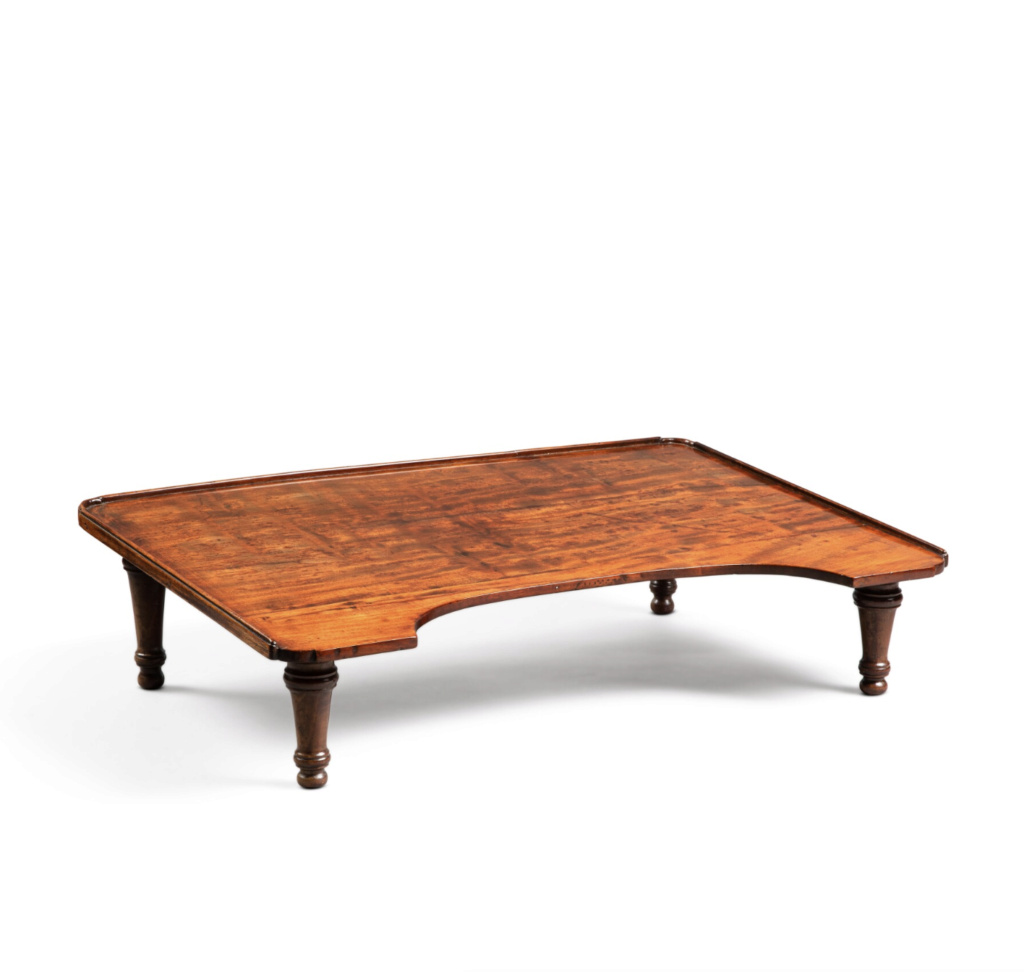
Note au catalogue
La marque du garde-meuble de la Reine
Cette marque à la fois spécifique et parlante était apposée à chaud par des fers. Gravée d’une façon circulaire autour du chiffre MA et surmontée d’une couronne fermée, cette marque fut apposée sur le mobilier de la souveraine à l’occasion d’un changement d’ameublement, d’une restauration ou d’un déplacement.
Parmi les compétences du Garde-Meuble privé, il revenait à Pierre-Charle Bonnefoy du Plan de s'occuper de l’ameublement des cabinets intérieurs de tous les châteaux royaux, mais aussi de Trianon qui servait d’ailleurs de siège à cette administration. A cette marque était parfois associée la marque du château, suivie du numéro d’inventaire du meuble, numéro correspondant certainement à l’inventaire général. Lorsque cette nouvelle marque était apposée, les anciennes marques du Garde-Meuble royal étaient alors en principe biffées.
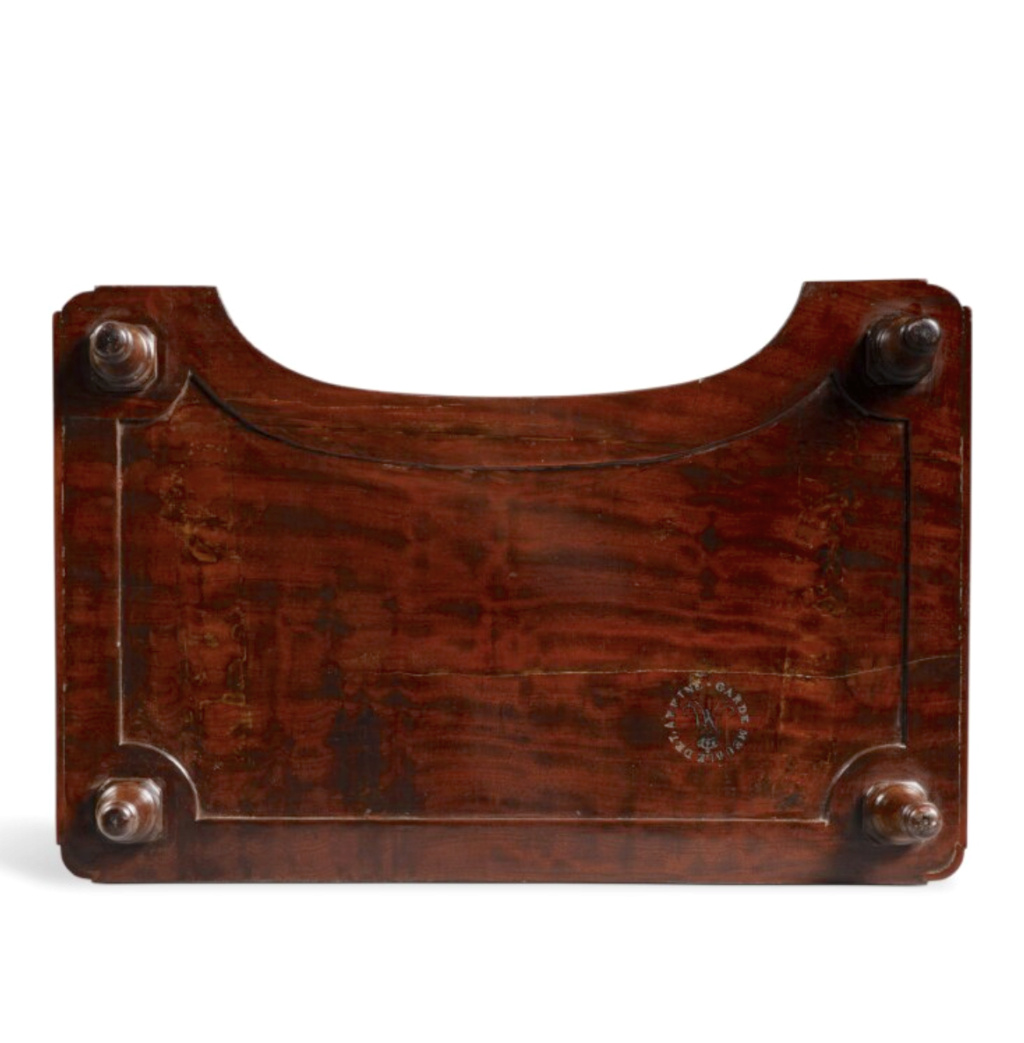
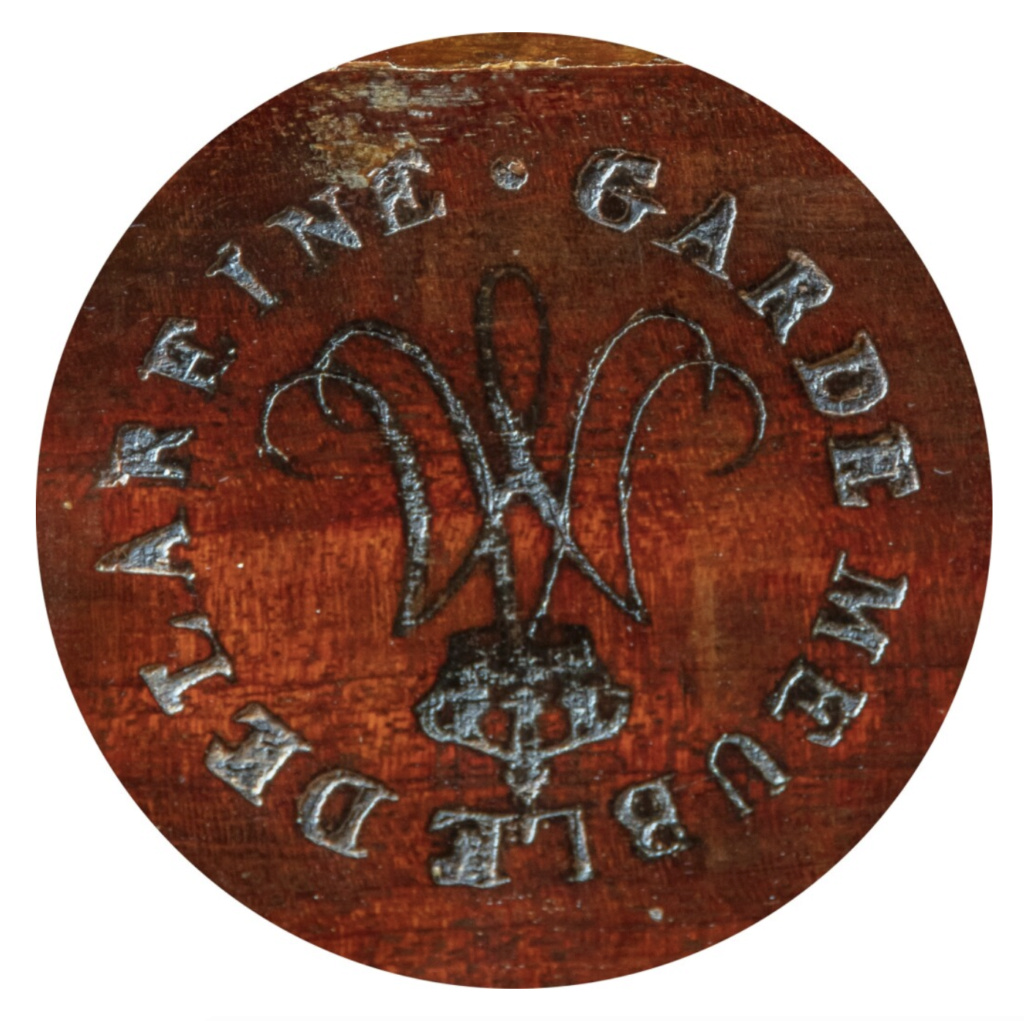
Que devinrent les papiers du garde-meuble privé ?
Cette belle mécanique fut troublée quand la souveraine fut contrainte, le 6 octobre 1789, de résider aux Tuileries. Bonnefoy occupa dès lors une maison dans l’enceinte des Tuileries, maison qui fut incendiée le 10 août 1792 et dont des papiers ne subsistent qu’un ou deux feuillets en partie calcinés et convertis par l’administration révolutionnaire en pochette à documents. Quant au grand registre de plus de 300 feuillets contenant l’inventaire de la totalité du mobilier de la souveraine, il semblerait qu’il ait été remis par Bonnefoy à l’administration révolutionnaire et aujourd’hui perdu.
Certains papiers ont été conservés par Bonnefoy puisque nous le voyons payer des boîtes d’archives en bois afin qu’elles soient déposées à la mairie du Charmel, commune dont il fut le seigneur, puis le maire. Hélas, la mairie, le château et tout leur contenu furent entièrement détruits pendant la Première Guerre Mondiale à l’exception de quelques documents communiqués à la Conservation de Versailles il y a plus de quarante ans.
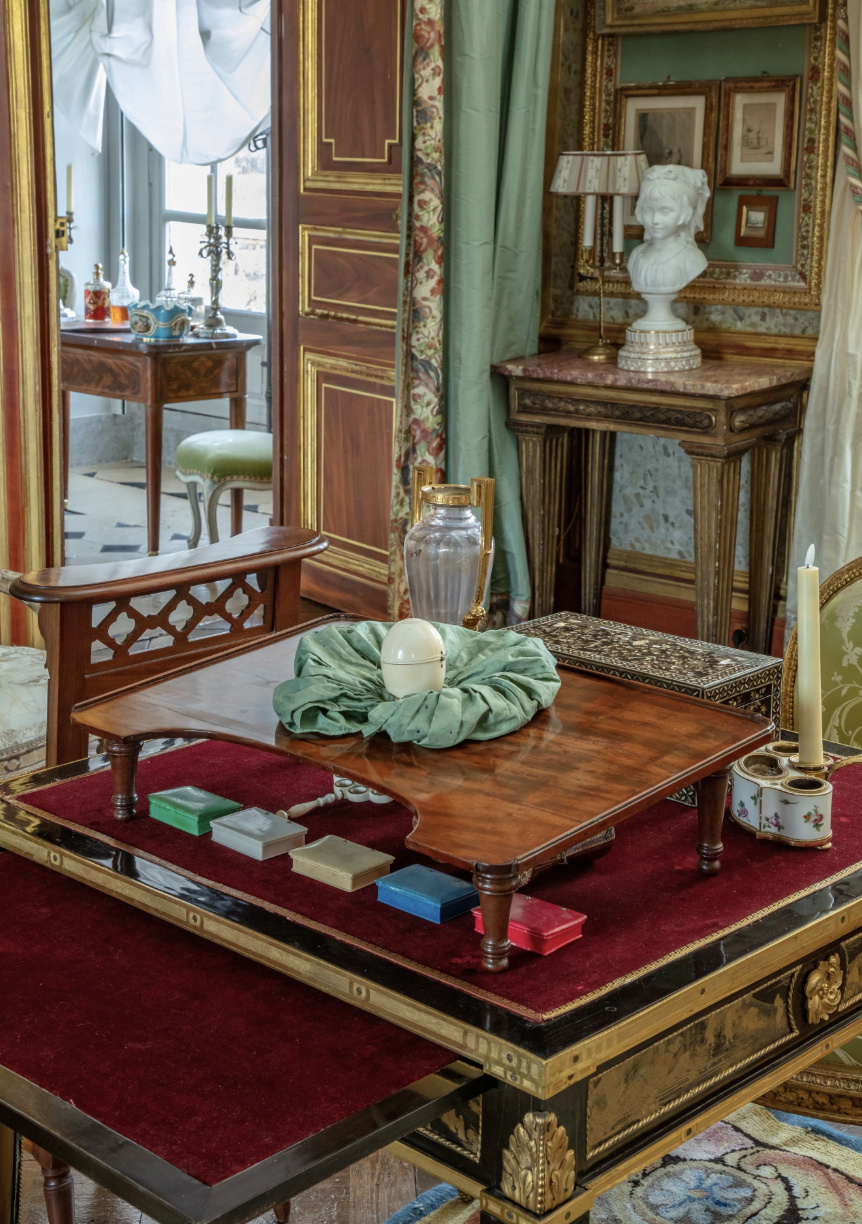
* Source et infos complémentaires : Sotheby's - Paris, vente du 16 mai 2023
Sera prochainement présenté en vente aux enchères :
Plateau à écrire royal en acajou moucheté d'époque Louis XVI
vers 1780
Le plateau cintré sur le devant, ceint d’une fine moulure, marque au feu " MA" couronné et "GARDE MEUBLE DE LA REINE" au revers
Haut. 16 cm, larg. 59 cm, prof. 38,5 cm
Provenance : Garde-Meuble privé de la reine Marie-Antoinette

Note au catalogue
La marque du garde-meuble de la Reine
Cette marque à la fois spécifique et parlante était apposée à chaud par des fers. Gravée d’une façon circulaire autour du chiffre MA et surmontée d’une couronne fermée, cette marque fut apposée sur le mobilier de la souveraine à l’occasion d’un changement d’ameublement, d’une restauration ou d’un déplacement.
Parmi les compétences du Garde-Meuble privé, il revenait à Pierre-Charle Bonnefoy du Plan de s'occuper de l’ameublement des cabinets intérieurs de tous les châteaux royaux, mais aussi de Trianon qui servait d’ailleurs de siège à cette administration. A cette marque était parfois associée la marque du château, suivie du numéro d’inventaire du meuble, numéro correspondant certainement à l’inventaire général. Lorsque cette nouvelle marque était apposée, les anciennes marques du Garde-Meuble royal étaient alors en principe biffées.


Que devinrent les papiers du garde-meuble privé ?
Cette belle mécanique fut troublée quand la souveraine fut contrainte, le 6 octobre 1789, de résider aux Tuileries. Bonnefoy occupa dès lors une maison dans l’enceinte des Tuileries, maison qui fut incendiée le 10 août 1792 et dont des papiers ne subsistent qu’un ou deux feuillets en partie calcinés et convertis par l’administration révolutionnaire en pochette à documents. Quant au grand registre de plus de 300 feuillets contenant l’inventaire de la totalité du mobilier de la souveraine, il semblerait qu’il ait été remis par Bonnefoy à l’administration révolutionnaire et aujourd’hui perdu.
Certains papiers ont été conservés par Bonnefoy puisque nous le voyons payer des boîtes d’archives en bois afin qu’elles soient déposées à la mairie du Charmel, commune dont il fut le seigneur, puis le maire. Hélas, la mairie, le château et tout leur contenu furent entièrement détruits pendant la Première Guerre Mondiale à l’exception de quelques documents communiqués à la Conservation de Versailles il y a plus de quarante ans.

* Source et infos complémentaires : Sotheby's - Paris, vente du 16 mai 2023

La nuit, la neige- Messages : 18132
Date d'inscription : 21/12/2013
 Re: Marques du mobilier et sceau du Garde-Meuble de la reine Marie-Antoinette
Re: Marques du mobilier et sceau du Garde-Meuble de la reine Marie-Antoinette
Voici présenté prochainement en vente aux enchères, mais je ne publie pas de façon visible l'interminable note au catalogue, car tout ne nous intéresse pas vraiment dans ce sujet du Garde-Meuble de la reine...
Royal Late Louis XV Carved Giltwood Console Table bearing the stamp of the Garde-Meuble de la reine Marie-Antoinette
Circa 1770
with a moulded Brèche d'Alep marble top; traces of earlier pale green decoration
H 90 cm; W 198 cm; D 68 cm
Provenance :
Possibly supplied in circa 1770 to the Petit Trianon, Versailles for the use of King Louis XV's favourite the comtesse du Barry, and subsequently gifted with the château by King Louis XVI to Queen Marie-Antoinette in 1774 (...)
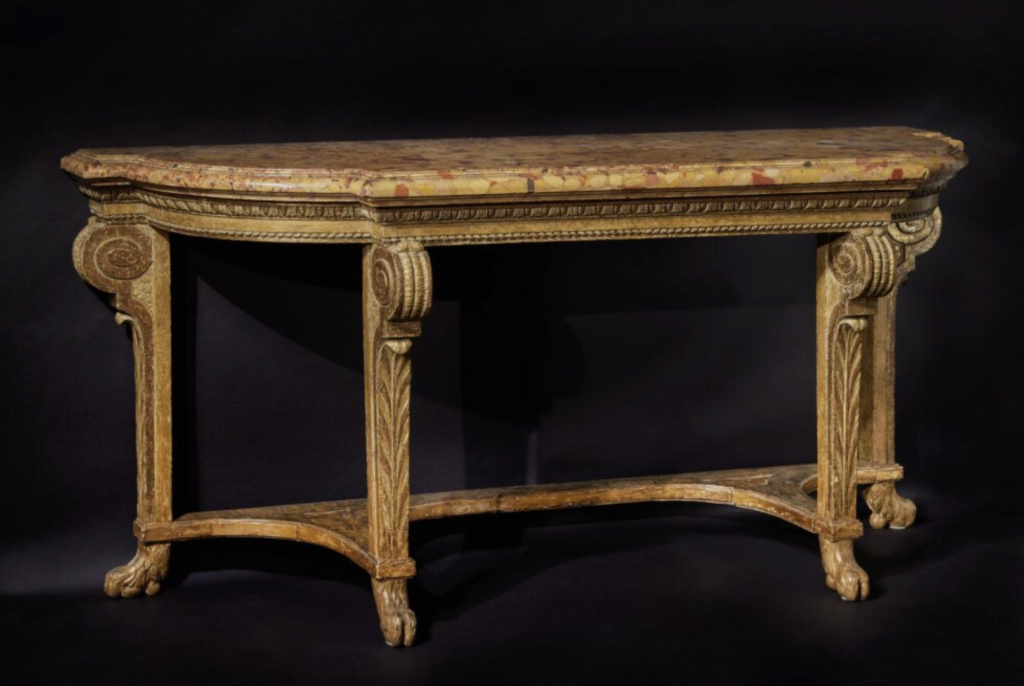
Catalogue Note
This console likely formed part of the original furnishings of the Petit Trianon, arguably the French royal residence most indelibly associated with Marie-Antoinette and her legacy, though it was in fact commissioned by King Louis XV in 1762 as a private retreat to enjoy with his favourite, Madame de Pompadour, who died in 1764, well before the building's completion. It would be inaugurated by the King's subsequent and final maîtresse en titre Jeanne Bécu, Comtesse du Barry (1743-1793) in 1768.
AN EARLY NEOCLASSICAL MASTERPIECE

A similar aesthetic was applied to the interior decoration, and the offered lot is related to two comparable giltwood tables now at the Petit Trianon and also bearing the stamp of Marie-Antoinette's Garde-Meuble de la reine that have been attributed to Guibert (Christian Baulez, 'Le Style Louis XVI,' Il mobile francese dal Medioevo al 1925, Milan 1981, p.84).
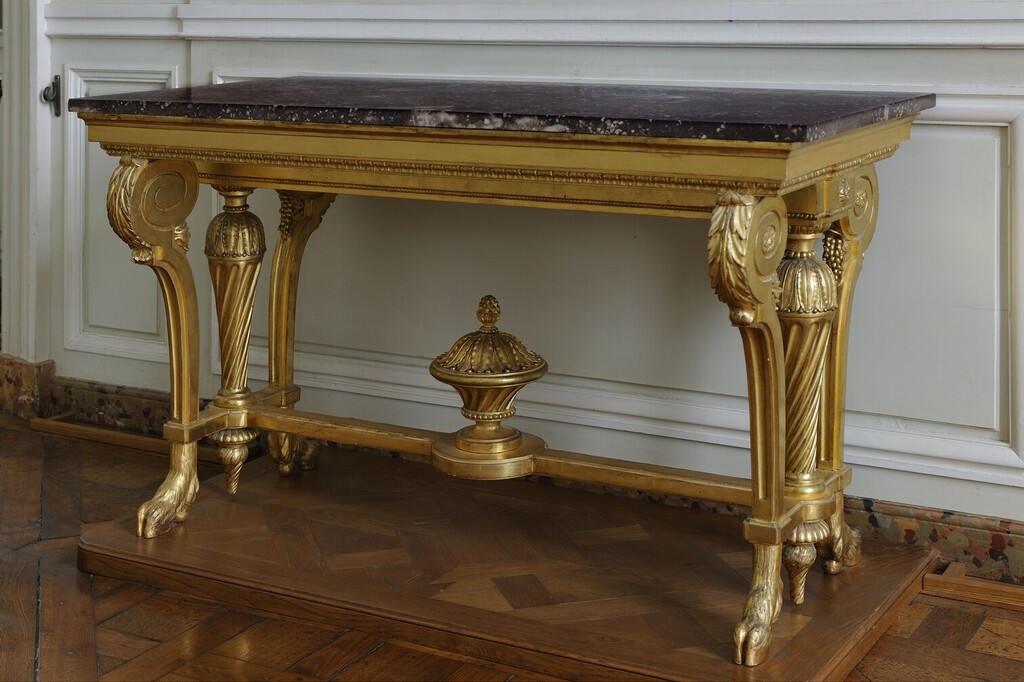
Cette console provient du mobilier privé de Marie-Antoinette dont elle porte la marque.
Attribuée à Honoré Guibert (sculpteur), d'après un modèle de Jean-François de Neufforge (dessinateur)
bois sculpté et doré, marbre, vers 1770
H. 75,8 ; L. 127 ; Pr. 63 cm
Image : Château de Versailles, Dist. RMN / Jean-Marc Manaï

Cette console provient du mobilier privé de Marie-Antoinette dont elle porte la marque.
Attribuée à Honoré Guibert (sculpteur)
bois sculpté et doré, marbre, vers 1770
H. 78 ; L. 138 ; Pr. 61 cm
Image : Château de Versailles, Dist. RMN / Jean-Marc Manaï

The current lot is also later gilded with a few traces of earlier pale green decoration, which correlates to the vert d'eau colour scheme of the Petit Trianon's boiseries, said to match the green of nature outside, that were overpainted in grey during the reign of Louis-Philippe and restored to the original colour in the 1970s under the curatorial directorship of Gérald Van der Kemp (Pierre Arrizoli-Clémentel, 'In memoriam: Gérald Van der Kemp', Versalia no.6, 2003).
The present lot's moulded breche d'Alep marble top also matches the antichambre's skirtings painted in simulated marble, following the tradition in the royal residences of decorating the board mouldings to match the marble fireplace in a room. The antichambre never had a fireplace and was heated by two large stoves flanking the door into the dining room, but retains brèche d'Alep marble floor slabs in front of the doors and windows.


MARIE-ANTOINETTE AND THE TRIANON: A COURT WITHIN A COURT
When taking possession of the Petit Trianon in 1774, Marie-Antoinette would have inherited all its existing furniture, which was then transferred to the authority of the Garde-Meuble de la reine, a distinct service from the larger Garde-Meuble de la Couronne, the official agency of the Royal Household responsible for furnishing and maintaining the interiors and contents of all the Crown properties.
Marie-Antoinette's furniture from the Trianon remained separate from the civil list and was administered by Pierre-Charles Bonnefoy du Plan, (1732-1824), concierge of the Petit Trianon. According to some contemporary sources, Marie-Antoinette changed little or nothing of the château's interiors. 'Tout fut conservé sans exception,' records Madame Campan, observing that the Queen even slept in a worn-out bed that had been used by Madame Du Barry (Jeanne-Louise-Henriette Campan, Mémoire sur la vie privée de Marie-Antoinette, reine de France et de Navarre, 1823, vol. I, p. 98).

As a collector and tastemaker with an eye for luxury and desire to promote the latest design trends, however, Marie-Antoinette would undertake some alterations to the Trianon's furnishings, though perhaps less so than in other royal residences such as Versailles and St Cloud, and primarily in the final years of the Ancien Régime.
Having already called upon the usual royal suppliers like Riesener and Jacob for her new small house in the Hameau, in 1787 she began refurbishing her chambre and boudoir in the Trianon with the help of Mique, creating the cabinet des glaces mouvantes painted with arabesques by the Rousseau brother, and commissioned the painted seat furniture aux épis by Jacob decorated with flowers and ears of wheat along with accompanying mahogany and gilt bronze tables by Schwerdfeger. All the Trianon furniture was sold at auction shortly thereafter by the Revolutionary government along with the rest of the contents of Versailles beginning in September 1793.

Unlike the property that fell under the purview of the Garde-Meuble de la Couronne, furniture stamped with the Garde-Meuble de la Reine mark rarely bears inventory numbers or chateau marks, and none of the records of the Queen's private garde-meuble have survived, believed to have disappeared after the abolition of the monarchy in 1792 - it has been suggested the Bonnefoy du Plan may have deliberately destroyed them to prevent evidence of the Queen's unbridled expenditure falling into the hands of the Revolutionary tribunal, or perhaps to avoid his own judicial ennuis, having also been imprisoned during the Reign of Terror but managing to avoid the same fate as his former employer.
In the absence of documentation is it impossible at present to have a clear idea of the furnishing of the Petit Trianon prior to 1787, further adding to the mystery, fascination and legend of Marie-Antoinette's idyllic private realm.
* Source et infos complémentaires : Sotheby's - New York, vente du 2 février 2024
Royal Late Louis XV Carved Giltwood Console Table bearing the stamp of the Garde-Meuble de la reine Marie-Antoinette
Circa 1770
with a moulded Brèche d'Alep marble top; traces of earlier pale green decoration
H 90 cm; W 198 cm; D 68 cm
Provenance :
Possibly supplied in circa 1770 to the Petit Trianon, Versailles for the use of King Louis XV's favourite the comtesse du Barry, and subsequently gifted with the château by King Louis XVI to Queen Marie-Antoinette in 1774 (...)

Catalogue Note
This console likely formed part of the original furnishings of the Petit Trianon, arguably the French royal residence most indelibly associated with Marie-Antoinette and her legacy, though it was in fact commissioned by King Louis XV in 1762 as a private retreat to enjoy with his favourite, Madame de Pompadour, who died in 1764, well before the building's completion. It would be inaugurated by the King's subsequent and final maîtresse en titre Jeanne Bécu, Comtesse du Barry (1743-1793) in 1768.
AN EARLY NEOCLASSICAL MASTERPIECE
- Le Petit Trianon:
- Designed by the king's premier architecte Ange-Jacques Gabriel (1698-1782), author of the Ecole Militaire and the façades of the Place de la Concorde, the Petit Trianon is located within the park of the château de Versailles, to the east of the earlier Grand Trianon on a site traditionally used for kitchen gardens and further developed into botanical gardens and a more formal jardin à la française in the 1750s. The château is in the form of a square pavilion, each side with five bays decorated externally in a restrained Corinthian order, with service apartments on the ground floor, a first floor piano nobile with formal reception rooms and an attic story with smaller private apartments. The relative austerity of the exterior contrasts with the more richly carved interior boiseries by the sculptor Honoré Jean Guibert (1720-1791), who also worked on the façades; the wood panelling alone was estimated to account for almost a third of the total building costs of nearly 750,000 livres (Gustave Desjardins, Le Petit Trianon : Histoire et description, Versailles 1885, p.28). The purity and decorative restraint of the edifice corresponded perfectly to the fashionable goût grec, a name applied to the first phase of the French neoclassical revival of the mid-1750s to mid-1760s, based on a somewhat fanciful but picturesque interpretation of ancient Greek architecture.

A similar aesthetic was applied to the interior decoration, and the offered lot is related to two comparable giltwood tables now at the Petit Trianon and also bearing the stamp of Marie-Antoinette's Garde-Meuble de la reine that have been attributed to Guibert (Christian Baulez, 'Le Style Louis XVI,' Il mobile francese dal Medioevo al 1925, Milan 1981, p.84).

Cette console provient du mobilier privé de Marie-Antoinette dont elle porte la marque.
Attribuée à Honoré Guibert (sculpteur), d'après un modèle de Jean-François de Neufforge (dessinateur)
bois sculpté et doré, marbre, vers 1770
H. 75,8 ; L. 127 ; Pr. 63 cm
Image : Château de Versailles, Dist. RMN / Jean-Marc Manaï

Cette console provient du mobilier privé de Marie-Antoinette dont elle porte la marque.
Attribuée à Honoré Guibert (sculpteur)
bois sculpté et doré, marbre, vers 1770
H. 78 ; L. 138 ; Pr. 61 cm
Image : Château de Versailles, Dist. RMN / Jean-Marc Manaï
- The 3 tables consoles:
- All three tables share the same straight uprights with goat's hoof feet and headed by scrolled console supports; simple stretcher and acanthus leaf carving along the lower edge of the frieze; and one with the same egg and dart moulding along the upper section of the frieze immediately underneath the marble; similar ornamental motifs appear in Guibert's carving on the château facades. One of the tables (OA 5273; illustrated in F.J.B. Watson, Le Meuble Louis XVI, Paris 1963, fig. 214) appears to be based on a model designed by the neoclassical architect Jean-François de Neufforge (1714-1791) and is recorded in the French national collections from 1855; the other (T 492 C ), was expressly acquired by the Imperial Garde-Meuble during the Second Empire in 1867 to form part of Empress Eugénie's l’exposition rétrospective dedicated to the memory of Marie-Antoinette held at the Petit Trianon, and has remained there since.
Both consoles were already believed in the 19th century to have formed part of the château's original furnishings, and the stylistic similarities and shared Garde-Meuble stamp suggest the current lot formed part of the same commission.
The two tables currently at the Petit Trianon are located in the first floor Antichambre, the first room immediately preceding the dining room in the enfilade of the principal apartments, which opens onto a terrace with a staircase leading into the garden and was designed to be directly accessible from the park without having to pass through the ground floor entrance. Interestingly, the offered lot, of greater width than the other two tables, is of a model akin to Louis XIV and Régence buffets or tables à gibier constructed in solid marble and used in château dining rooms and entrance halls, and it could have fit on either the east or south wall of the antichambre where the two in situ tables are now placed.

The current lot is also later gilded with a few traces of earlier pale green decoration, which correlates to the vert d'eau colour scheme of the Petit Trianon's boiseries, said to match the green of nature outside, that were overpainted in grey during the reign of Louis-Philippe and restored to the original colour in the 1970s under the curatorial directorship of Gérald Van der Kemp (Pierre Arrizoli-Clémentel, 'In memoriam: Gérald Van der Kemp', Versalia no.6, 2003).
The present lot's moulded breche d'Alep marble top also matches the antichambre's skirtings painted in simulated marble, following the tradition in the royal residences of decorating the board mouldings to match the marble fireplace in a room. The antichambre never had a fireplace and was heated by two large stoves flanking the door into the dining room, but retains brèche d'Alep marble floor slabs in front of the doors and windows.


MARIE-ANTOINETTE AND THE TRIANON: A COURT WITHIN A COURT
- Petit Trianon:
- Upon Louis XV's death in 1774, Madame du Barry was swiftly exiled from Versailles, and the new king Louis XVI promptly deeded the Petit Trianon to his wife Marie-Antoinette, with the possibly apocryphal remark recorded by the Abbé Baudeau: Vous aimez les fleurs Madame ? J'ai un bouquet à vous offrir. C'est le Petit Trianon.
The young queen relished her new acquisition as a refuge from the rigorous formality of royal life and sought to create a refuge where she could entertain friends away from the gaze of unsympathetic courtiers and partake of the delights of the countryside, newly fashionable thanks to the writings of Rousseau. In 1777 she charged the royal architect Richard Mique (1728-1794), successor to Gabriel, with transforming the park's formal botanical gardens into a more natural jardin à l'anglaise, with a grotto, artificial lake and follies including a classical Temple d'Amour and exquisitely decorated Belvedere pavilion. She next engaged Mique in 1783 to create the celebrated Hameau de la Reine, a series of outwardly rustic dwellings, agricultural buildings and a working farm where she received her most intimate acquaintances and introduced her children to aspects of country life. At the Trianon the queen reportedly said ici, je ne suis pas reine, je suis moi-même, and it was her life away from the salons of the main palace at Versailles that contributed most greatly to the public perception of her persona that persists today.
When taking possession of the Petit Trianon in 1774, Marie-Antoinette would have inherited all its existing furniture, which was then transferred to the authority of the Garde-Meuble de la reine, a distinct service from the larger Garde-Meuble de la Couronne, the official agency of the Royal Household responsible for furnishing and maintaining the interiors and contents of all the Crown properties.
Marie-Antoinette's furniture from the Trianon remained separate from the civil list and was administered by Pierre-Charles Bonnefoy du Plan, (1732-1824), concierge of the Petit Trianon. According to some contemporary sources, Marie-Antoinette changed little or nothing of the château's interiors. 'Tout fut conservé sans exception,' records Madame Campan, observing that the Queen even slept in a worn-out bed that had been used by Madame Du Barry (Jeanne-Louise-Henriette Campan, Mémoire sur la vie privée de Marie-Antoinette, reine de France et de Navarre, 1823, vol. I, p. 98).

As a collector and tastemaker with an eye for luxury and desire to promote the latest design trends, however, Marie-Antoinette would undertake some alterations to the Trianon's furnishings, though perhaps less so than in other royal residences such as Versailles and St Cloud, and primarily in the final years of the Ancien Régime.
Having already called upon the usual royal suppliers like Riesener and Jacob for her new small house in the Hameau, in 1787 she began refurbishing her chambre and boudoir in the Trianon with the help of Mique, creating the cabinet des glaces mouvantes painted with arabesques by the Rousseau brother, and commissioned the painted seat furniture aux épis by Jacob decorated with flowers and ears of wheat along with accompanying mahogany and gilt bronze tables by Schwerdfeger. All the Trianon furniture was sold at auction shortly thereafter by the Revolutionary government along with the rest of the contents of Versailles beginning in September 1793.

Unlike the property that fell under the purview of the Garde-Meuble de la Couronne, furniture stamped with the Garde-Meuble de la Reine mark rarely bears inventory numbers or chateau marks, and none of the records of the Queen's private garde-meuble have survived, believed to have disappeared after the abolition of the monarchy in 1792 - it has been suggested the Bonnefoy du Plan may have deliberately destroyed them to prevent evidence of the Queen's unbridled expenditure falling into the hands of the Revolutionary tribunal, or perhaps to avoid his own judicial ennuis, having also been imprisoned during the Reign of Terror but managing to avoid the same fate as his former employer.
In the absence of documentation is it impossible at present to have a clear idea of the furnishing of the Petit Trianon prior to 1787, further adding to the mystery, fascination and legend of Marie-Antoinette's idyllic private realm.
* Source et infos complémentaires : Sotheby's - New York, vente du 2 février 2024

La nuit, la neige- Messages : 18132
Date d'inscription : 21/12/2013
 Re: Marques du mobilier et sceau du Garde-Meuble de la reine Marie-Antoinette
Re: Marques du mobilier et sceau du Garde-Meuble de la reine Marie-Antoinette
Prochainement aux enchères...
Table à ouvrage ou table tricoteuse d’époque Louis XVI, estampillée A. Weisweiler et portant la marque au fer du Garde-Meuble de la Reine
En chêne, acajou, placage d’acajou ronceux, laiton et bronze doré, à deux plateaux oblong, cintrés à leurs extrémités, celui inférieur de forme rognon, l’ensemble réunis par des montants droits, cannelés, foncés de laiton, les pieds cambrés. Le décor de bronzes - lingotières, encadrements de frises perlées complétant une ornementation de bandes striées à la partie supérieure, sabot en forme de feuilles d’acanthe perlées - suit les lignes générales du meuble et les soulignent tels les grattoirs sur les pieds en écho à ceux surmontant les montants à la partie supérieure. La partie du plateau supérieur, située à l’aplomb de la découpe du plateau inférieur, s’ouvre par un abattant retenu par deux butées à ressort.
Estampillée deux fois de manière peu lisible A Weisweiler et marque au fer Garde-Meuble de la Reine entourant les initiales MA surmontées d’une couronne royale.
H : 74.5 - L : 68.5 - P : 35 cm
Usures, restaurations, roulettes manquantes

Adam Weisweiler (1744-1820) reçu maître le 26 mars 1778
Le meuble que nous présentons est très proche de la table, également estampillée Weisweiler, mais sans la marque du Garde-Meuble de la Reine, datée vers 1787, conservée au Musée Carnavalet sous le N° d’inventaire (inv. MB 487), et provenant du leg d’Henriette Bouvier. Ils rejoignent un certain nombre de petits meubles, bonheurs-du-jour, consoles, guéridons, tables, caractérisés par leur finesse, simplicité et légèreté, illustrant une veine de la création de l’artiste ainsi que son goût porté sur des placage unis exécutés dans des bois soigneusement choisis, notamment l’acajou unis ou ronceux, et dont l’élégance et l’exécution étaient très probablement lié aux liens tissés entre leur créateur et les marchands merciers.

Le Garde-Meuble de la Reine
Depuis son institution en 1663 par Colbert, le Garde Meuble de la Couronne est l'administration chargée de la gestion du mobilier et des objets d'art destinés à l'ornement des appartements royaux. Sous Louis XVI, c’est probablement à partir de 1784 que Marie-Antoinette obtient le privilège d'un garde-meuble privé, indépendant du Garde-Meuble de la Couronne, administré par son intendant Pierre-Charles Bonnefoy du Plan (1732-1824). Il semble que la marque circulaire de cette administration était apposée sur le mobilier à l’occasion du déplacement de ce dernier, du changement d’ameublement ou de restauration. La plupart des archives ayant disparu lors des troubles révolutionnaires et de la Première Guerre Mondiale, il est très délicat de retracer l’historique des meubles.


Un meuble caractéristique du XVIIIe siècle La table tricoteuse est un meuble bien caractéristique du XVIIIe siècle parisien. Petite, légère, mobile, maniable, elle était dite " volante " et servait d’appoint près d’un siège ou d’une table de salle à manger. Les inventaires d’époque évoquent les noms donnés à ces tables en raison de sa forme ou de son utilisation : table creuse, table en auge, table en crachoir, table à ouvrages pour la couture, tables à cabaret pour le café ou le chocolat. On ne sait si ce fut Riesener, le Garde-Meuble de la Couronne ou un marchand mercier qui fut le concepteur et le diffuseur de ce type de table.
Bibliographie : A. Forray-Carlier, Le Mobilier du musée Carnavalet, Dijon, 2000, pp. 170-171, n°63. La demeure parisienne au XVIIIe siècle. Collection Henriette Bouvier léguée au Musée Carnavalet, Paris, 1968, réédition 1976. P. Lemonnier, Weisweiler, Paris, 1983. Nous remercions M Ulysse Jardat du musée Carnavalet pour sa disponibilité.
 Source : Millon
Source : Millon
Table à ouvrage ou table tricoteuse d’époque Louis XVI, estampillée A. Weisweiler et portant la marque au fer du Garde-Meuble de la Reine
En chêne, acajou, placage d’acajou ronceux, laiton et bronze doré, à deux plateaux oblong, cintrés à leurs extrémités, celui inférieur de forme rognon, l’ensemble réunis par des montants droits, cannelés, foncés de laiton, les pieds cambrés. Le décor de bronzes - lingotières, encadrements de frises perlées complétant une ornementation de bandes striées à la partie supérieure, sabot en forme de feuilles d’acanthe perlées - suit les lignes générales du meuble et les soulignent tels les grattoirs sur les pieds en écho à ceux surmontant les montants à la partie supérieure. La partie du plateau supérieur, située à l’aplomb de la découpe du plateau inférieur, s’ouvre par un abattant retenu par deux butées à ressort.
Estampillée deux fois de manière peu lisible A Weisweiler et marque au fer Garde-Meuble de la Reine entourant les initiales MA surmontées d’une couronne royale.
H : 74.5 - L : 68.5 - P : 35 cm
Usures, restaurations, roulettes manquantes

Adam Weisweiler (1744-1820) reçu maître le 26 mars 1778
Le meuble que nous présentons est très proche de la table, également estampillée Weisweiler, mais sans la marque du Garde-Meuble de la Reine, datée vers 1787, conservée au Musée Carnavalet sous le N° d’inventaire (inv. MB 487), et provenant du leg d’Henriette Bouvier. Ils rejoignent un certain nombre de petits meubles, bonheurs-du-jour, consoles, guéridons, tables, caractérisés par leur finesse, simplicité et légèreté, illustrant une veine de la création de l’artiste ainsi que son goût porté sur des placage unis exécutés dans des bois soigneusement choisis, notamment l’acajou unis ou ronceux, et dont l’élégance et l’exécution étaient très probablement lié aux liens tissés entre leur créateur et les marchands merciers.

Le Garde-Meuble de la Reine
Depuis son institution en 1663 par Colbert, le Garde Meuble de la Couronne est l'administration chargée de la gestion du mobilier et des objets d'art destinés à l'ornement des appartements royaux. Sous Louis XVI, c’est probablement à partir de 1784 que Marie-Antoinette obtient le privilège d'un garde-meuble privé, indépendant du Garde-Meuble de la Couronne, administré par son intendant Pierre-Charles Bonnefoy du Plan (1732-1824). Il semble que la marque circulaire de cette administration était apposée sur le mobilier à l’occasion du déplacement de ce dernier, du changement d’ameublement ou de restauration. La plupart des archives ayant disparu lors des troubles révolutionnaires et de la Première Guerre Mondiale, il est très délicat de retracer l’historique des meubles.


Un meuble caractéristique du XVIIIe siècle La table tricoteuse est un meuble bien caractéristique du XVIIIe siècle parisien. Petite, légère, mobile, maniable, elle était dite " volante " et servait d’appoint près d’un siège ou d’une table de salle à manger. Les inventaires d’époque évoquent les noms donnés à ces tables en raison de sa forme ou de son utilisation : table creuse, table en auge, table en crachoir, table à ouvrages pour la couture, tables à cabaret pour le café ou le chocolat. On ne sait si ce fut Riesener, le Garde-Meuble de la Couronne ou un marchand mercier qui fut le concepteur et le diffuseur de ce type de table.
Bibliographie : A. Forray-Carlier, Le Mobilier du musée Carnavalet, Dijon, 2000, pp. 170-171, n°63. La demeure parisienne au XVIIIe siècle. Collection Henriette Bouvier léguée au Musée Carnavalet, Paris, 1968, réédition 1976. P. Lemonnier, Weisweiler, Paris, 1983. Nous remercions M Ulysse Jardat du musée Carnavalet pour sa disponibilité.

Gouverneur Morris- Messages : 11795
Date d'inscription : 21/12/2013
Page 2 sur 2 •  1, 2
1, 2
 Sujets similaires
Sujets similaires» Écritoires et plateaux à écrire du Garde-Meuble de Marie-Antoinette
» Mobilier de Marie-Antoinette au palais des Tuileries
» Marie-Thérèse Sallantin, responsable de la garde-robe aux atours de Marie-Antoinette, puis commissionnaire au Temple
» Quel est le meuble le plus emblématique de Marie-Antoinette ?
» Le mobilier de Marie-Antoinette au château de Versailles
» Mobilier de Marie-Antoinette au palais des Tuileries
» Marie-Thérèse Sallantin, responsable de la garde-robe aux atours de Marie-Antoinette, puis commissionnaire au Temple
» Quel est le meuble le plus emblématique de Marie-Antoinette ?
» Le mobilier de Marie-Antoinette au château de Versailles
LE FORUM DE MARIE-ANTOINETTE :: Le patrimoine de Marie-Antoinette :: Le mobilier et les arts décoratifs
Page 2 sur 2
Permission de ce forum:
Vous ne pouvez pas répondre aux sujets dans ce forum